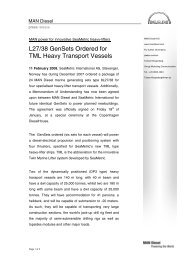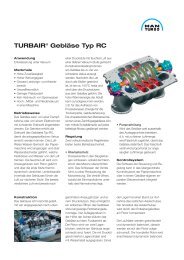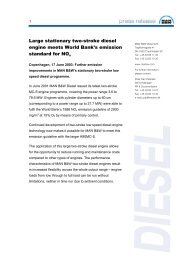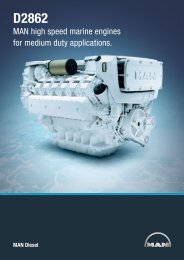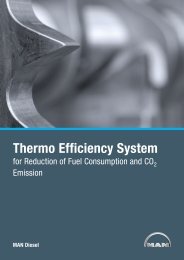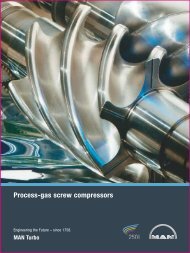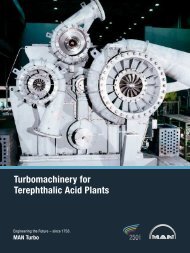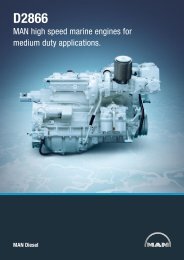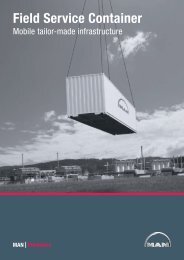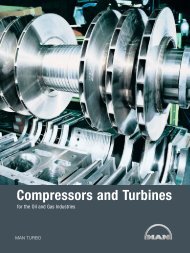Download file - MAN Diesel & Turbo SE
Download file - MAN Diesel & Turbo SE
Download file - MAN Diesel & Turbo SE
You also want an ePaper? Increase the reach of your titles
YUMPU automatically turns print PDFs into web optimized ePapers that Google loves.
In general, a turbocharger with a normal<br />
layout can be used in connection with<br />
an exhaust gas bypass. However, in a<br />
few cases a turbocharger modification<br />
may be needed.<br />
The exhaust gas bypass system ensures<br />
that when the engine is running at part<br />
load at low ambient air temperatures,<br />
the load-dependent scavenge air pressure<br />
is close to the corresponding pressure<br />
on the scavenge air pressure curve<br />
which is valid for ISO ambient conditions.<br />
When the scavenge air pressure<br />
exceeds the read-in ISO-based scavenge<br />
air pressure curve, the bypass valve<br />
will variably open and, irrespective of<br />
the ambient conditions, will ensure that<br />
the engine is not overloaded. At the<br />
same time, it will keep the exhaust gas<br />
temperature relatively high.<br />
The latest generations of turbochargers<br />
with variable flow, e.g. the VTA (Variable<br />
Turbine Area) system from <strong>MAN</strong> <strong>Diesel</strong>,<br />
can replace the variable bypass and ensure,<br />
the same scavenge air pressure<br />
control.<br />
Other low temperature precautions<br />
Low ambient air temperature and low<br />
seawater temperature conditions come<br />
together. The cooling water inlet temperature<br />
to the lube oil cooler should<br />
not be lower than 10°C, as otherwise<br />
the viscosity of the oil in the cooler will<br />
be too high, and the heat transfer inadequate.<br />
This means that some of the<br />
cooling water should be recirculated to<br />
keep up the temperature.<br />
Furthermore, to keep the lube oil viscosity<br />
low enough to ensure proper suction<br />
conditions in the lube oil pump, it may<br />
be advisable to install heating coils near<br />
the suction pipe in the lube oil bottom<br />
tank.<br />
The following additional modifications of<br />
the standard design practice should be<br />
considered as well:<br />
• Larger electric heaters for the cylinder<br />
lubricators or other cylinder oil<br />
ancillary equipment<br />
• Cylinder oil pipes to be further heat<br />
traced/insulated<br />
• Upgraded steam tracing of fuel oil<br />
pipes<br />
Steam production<br />
kg/h<br />
2,500<br />
2,000<br />
1,500<br />
1,000<br />
500<br />
0<br />
40<br />
6S60MC-C7/ME-C7<br />
SMCR = 13,560 kW at 105 r/min<br />
Air intake temperature: 0 °C<br />
Cooling water temperature: 10°C<br />
Extra steam needed<br />
• Increased preheater capacity for<br />
jacket water during standstill<br />
• Different grades of lubricating oil for<br />
turbochargers<br />
• Space heaters for electric motors<br />
• Sea chests must be arranged so that<br />
blocking with ice is avoided.<br />
Ships with ice class notation<br />
For ships with the FinnishSwedish ice<br />
class notation 1C, 1B, 1A and even<br />
1A super or similar, all <strong>MAN</strong> B&W<br />
twostroke diesel engines meet the<br />
ice class demands, i.e. there will be no<br />
changes to the main engines.<br />
Surplus steam<br />
50 60 70 80 90 100%<br />
Total steam production,<br />
with exhaust gas bypass<br />
Total steam production,<br />
without bypass<br />
Steam consumption<br />
SMCR<br />
Engine shaft power<br />
Fig. 5: Expected steam production by exhaust gas boiler at winter ambient conditions (0 °C air) for main<br />
engine 6S60MC-C7/ME-C7 with/without a load-dependent low air temperature exhaust gas bypass system<br />
Ambient Temperature Operation and Matching - <strong>MAN</strong> B&W Two-stroke Engines<br />
11



